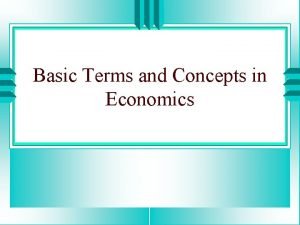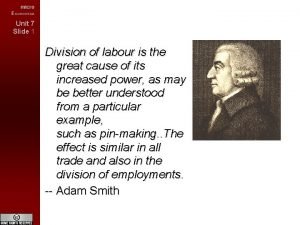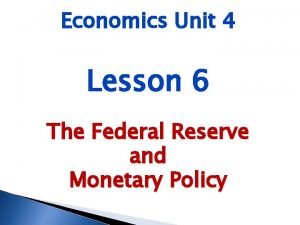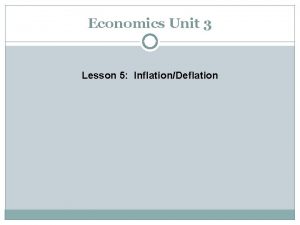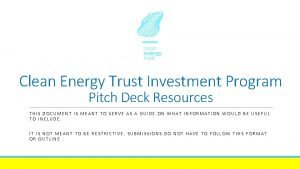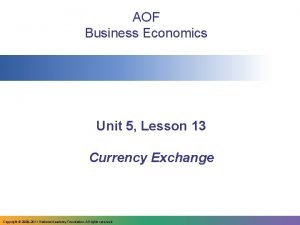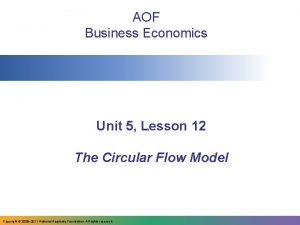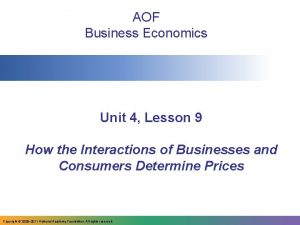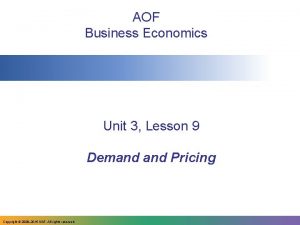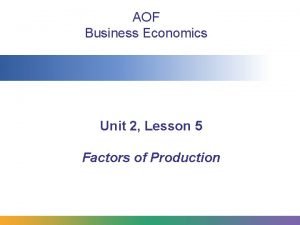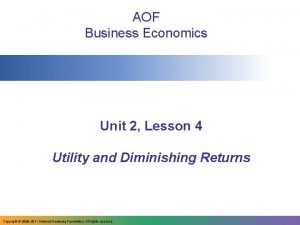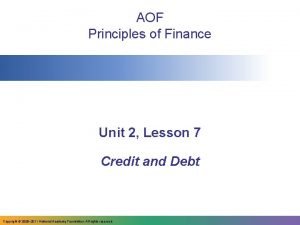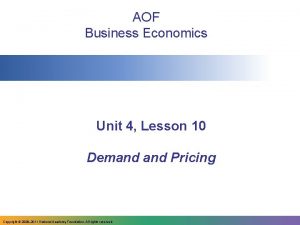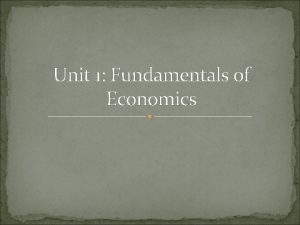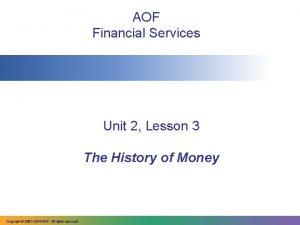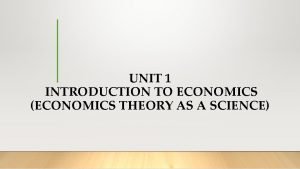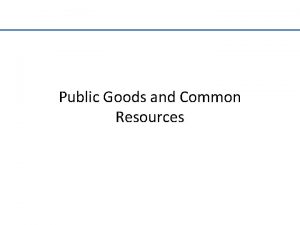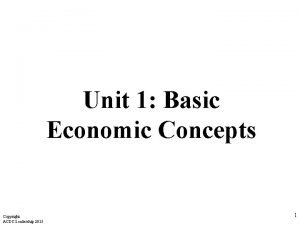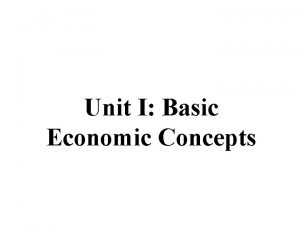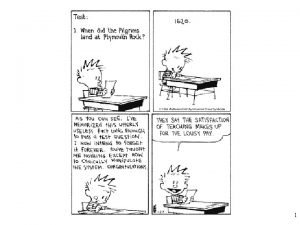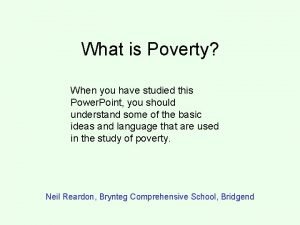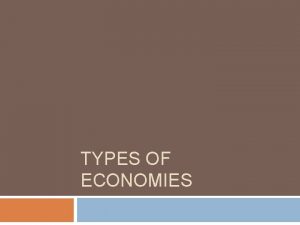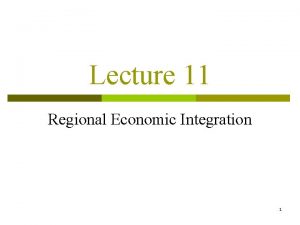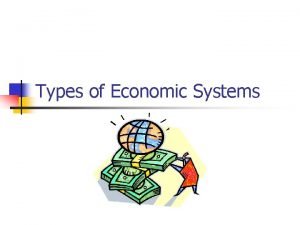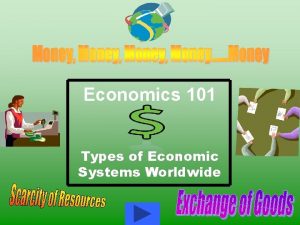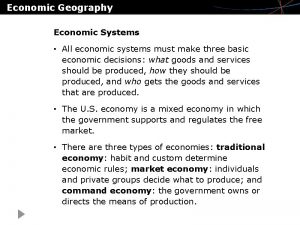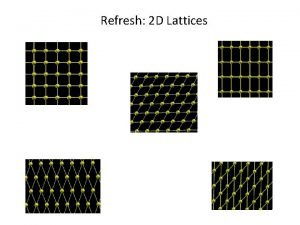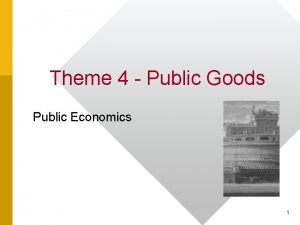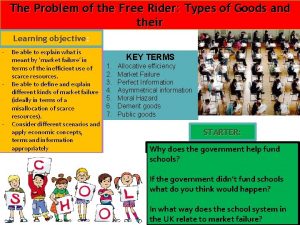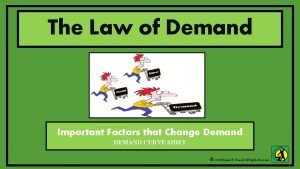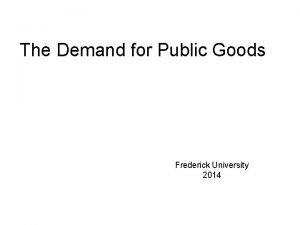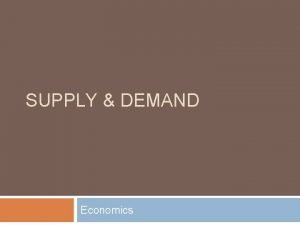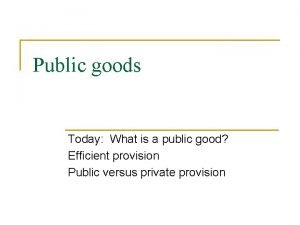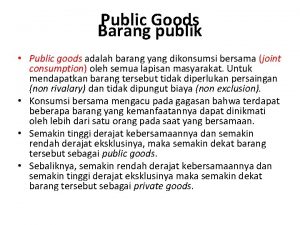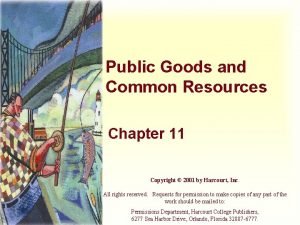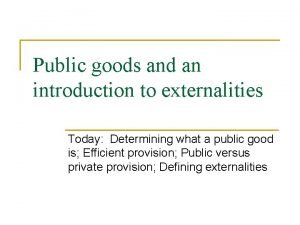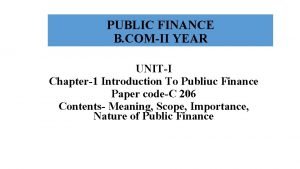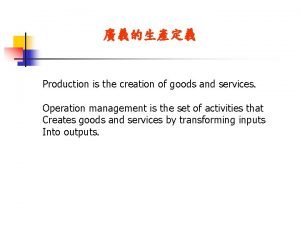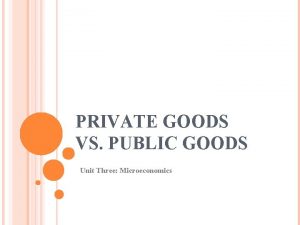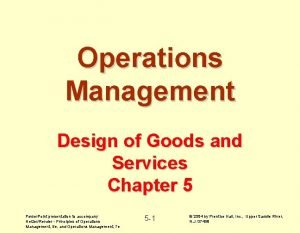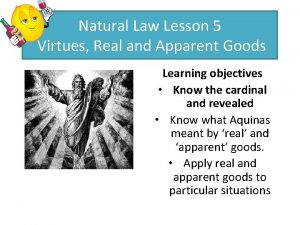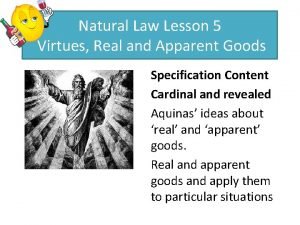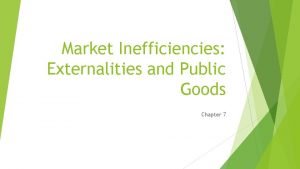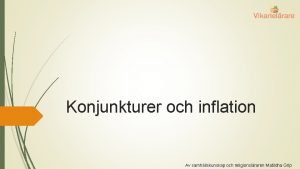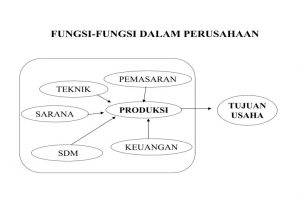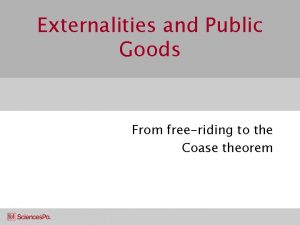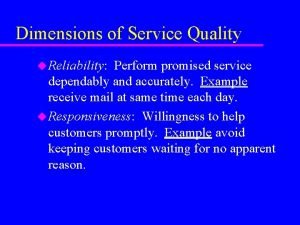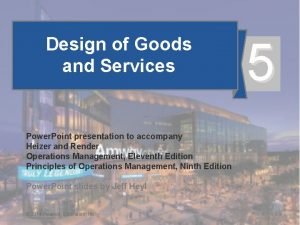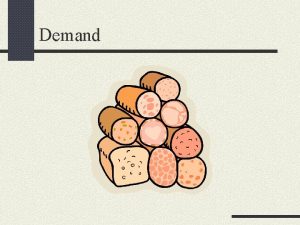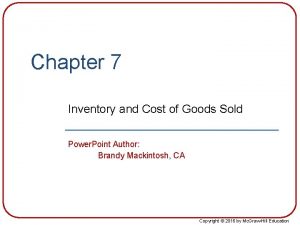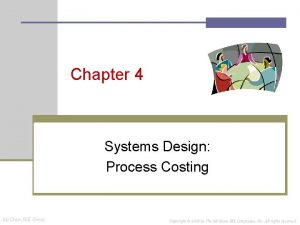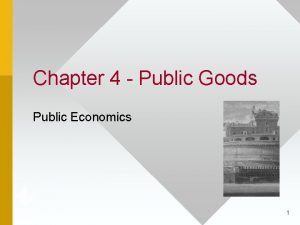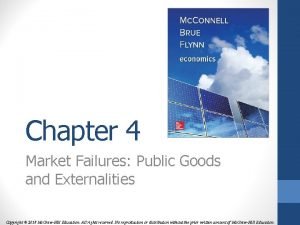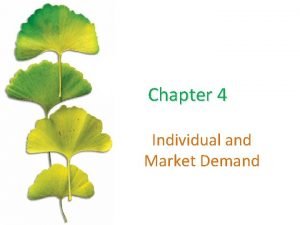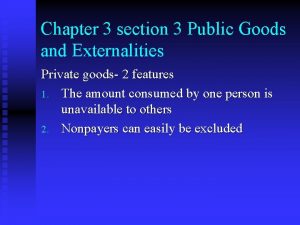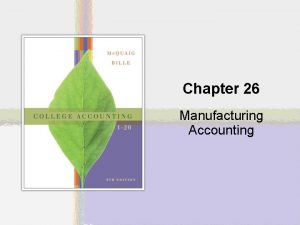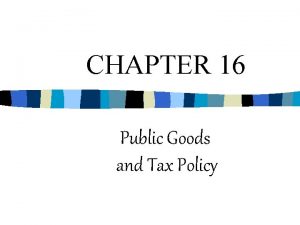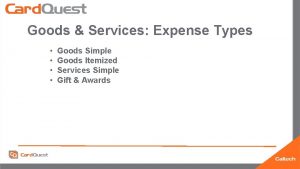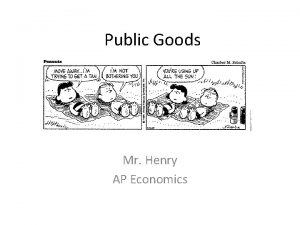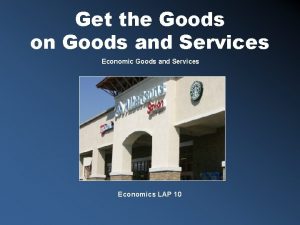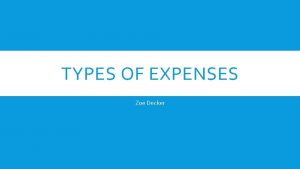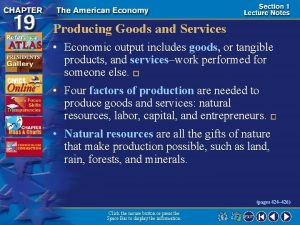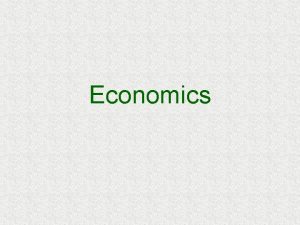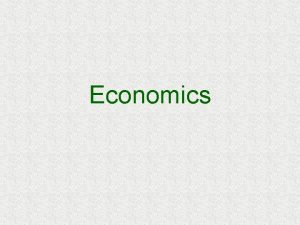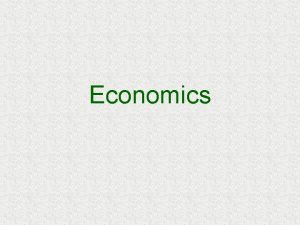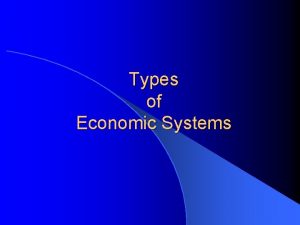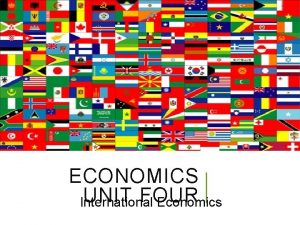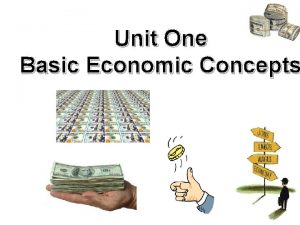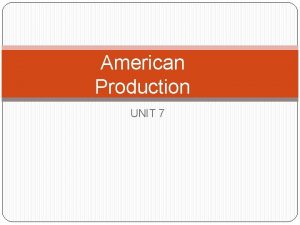Economics Unit 1 Types of goods Economic goods






























































































































- Slides: 126

Economics Unit 1

Types of goods � Economic goods are scarce and therefore have an opportunity cost eg. Food, petrol � Free goods have no opportunity cost eg. Air, outer space � What is opportunity cost? Any decision that involves a choice between two or more options has an opportunity cost. It is known as “the cost forgone”

Microeconmics in action What is a market? A place where buyers and sellers meet to exchange goods and services

Where do markets occur? A market Door-to-door shop Telesales Supermarket Restaurant online Catalogue

Characteristics Dynamic • Changing quite rapidly eg. Stock market, technology, fashion Static • Stays the same Growth • More demand, • More entering the market Competitive • Lots of supplies in the same market competing to sell Monopoly • One main player dominates the market eg. London Underground Oligopoly • A few key players dominate the market eg. supermarkets

Microeconomics � Microeconomics examines how decisions and behaviours affect the supply and demand for goods and services, which determines prices, and how prices, in turn, determine the quantity supplied and quantity demanded of goods and services. Price Supply Demand quantity

Economic data Lies, damned lies, and statistics a phrase describing the persuasive power of numbers.

Data collection � Economists collect data for 2 main reasons: - to support or refute a theory (eg. Increase in benefits will increase number of unemployed) - provide support for economic policies � Collecting data is difficult - inaccurate - surveys: biased, inaccurate - claimant data: are they genuine - experimental data: not being able to make a conclusive statement

Data can mislead – be critical! � Data is often presented in many forms to inform and MISLEAD the reader - has it been taken out of context? - look at the time period of the graph/table - often key trends are picked out which can be misleading rather than showing entire decade.

Statements � Value judgements = statements that are not testable or cannot be verified and depend on the views of the individual and the values they hold � Normative = statements that are not testable � Positive = statements that can be tested against real world data

Production Possibility Curve It looks at the allocation of resources and what a country/economy can produce. It represents the different combinations of all goods produced if an economy is fully and efficiently employed

What does a country produce? � Consumer goods (final goods) bought by individuals to satisfy wants and needs eg. TV (durable) and washing powder (non durable) � Capital goods (producer goods or intermediate goods) machines used to produce consumer goods � Purchase of consumer goods = consumption � Purchase of capital goods = investment

Production possibility frontiers capital 20 10 When we move from A to B, the opportunity cost is 10 capital goods. If we went from B to A, the opportunity cost would be 10 consumer goods. A B consumer

Production possibility frontiers � At any point on the curve, we have maximum capacity � As you slide along the curve, you will always have opportunity costs � At any point on the curve we are not wasting resources � It is the maximum that can be produced given a fixed set of resources and technology. � Productive efficiency = not wasting resources or under using them. � Allocative efficiency = it is not possible to make someone better off without making someone worse off.

Resources not fully utilised capital H If there is unemployment, idle factories or inefficiencies then an economy cannot operate on the PPF. When the point is under the curve, it means the economy is not working at its full capacity. Happens during a recession. consumer

Shifts inwards of PPF capital If a shift inwards of the PPB = economic contraction. Decrease in the number of workers (migration), economic collapse. consumer

Shift outwards of PPF capital If a shift outwards of the PPB = economic growth. Increase in the number of workers, factories, quality of resources, investment and technology consumer

Increase in productive efficiency of one good capital This represents only an increase in the productive efficiency of consumer goods. The economy has become better at producing consumer goods. It is a shift but only at the consumer end. There is no opportunity cost. consumer

Factors of production Production is a process or a set of processes that converts inputs into outputs

input process output

Factors of production land • Air • Land • Forests • Sea labour capital Enterprise • Workforce • Value of a worker – human capital • Stock used to make other goods eg. Tools, machines or money to buy equipment • Risk takers • entrepreneurs

Business and Economics Private vs public Objectives £ terms E of D

Private sector � Business activity owned financed and controlled by private individuals - sole traders - partnerships - private limited companies - public limited companies - co-operatives - franchises

environmen t Image and reputation profit Quality and innovation survival Private sector businesses objectives Efficiency Share price Sales and revenue Social issues Market power/sha re

Public Sector (tax payers money) � Business activity owned, financed and controlled by the state through government or local authorities � Government – key departments set policy and monitor implementation � Local authorities – county councils, district councils, parish councils � Health trusts � Public corporations - BBC

Access – available to all regardless of location or income Equity – available to anyone whatever their background, status, income, class, race, religion etc Public sector businesses objectives Affordability – services offered at prices that are cheaper than private sector or free at the point of use Quality – high quality services that do not cut corners

Production & Efficiency Production process of converting inputs into outputs Productivity refers to the rate of output

Specialisation � Production of a limited range of goods by an individual, firm or country. Done in cooperation a complete range of products and services are produced � Specialisation requires a system of exchange

Division of labour � Increased skill � Saves time � Work to one’s natural strength � Use of specialist equipment increases productivity � Very repetitive � Demotivated � Get bored Advantages Disadvantages

Production vs productivity � Convert input into output � Production is the means bu which consumer wants are satisfied � How effective this process is with reference to labour, land, capital equipment � Total output per time period Number of units of labour Total output Total amounts of inputs used � Production Productivity

What can higher productivity do? Lower average costs • Lower prices • Increase demand • Increase employment Increase competitiveness • UK and internationally Increase profits Increase higher real wages Increase growth of the economy • PPB shift out and right Aim to close the productivity gap • The difference between where we are now and where we want to be

What do we rely on to achieve high levels of productivity? Style of manager Motivational techniques Better training High productivity Change the way a business process works How qualified staff are Better equipment

Productivity efficiency (PE) � Costs are lowered as more is produced because fixed costs can be spread over a greater number of units. Therefore cost per unit are lowered. � FC + VC = TC � The point where you are operating at the lowest costs

Productive efficiency (PE) � Achieved when a firms output is produced at minimum average total cost (ATC) Cost of production Economies of scale diseconomies of scale output Productive efficiency

Economies of scale � The purpose is to lower average costs as output increases. They represent an improvement in productive efficiency ◦ - give competitive advantage ◦ - lower prices ◦ - higher profits

Types of economies of scale technical networking managerial Purchasing marketing Risk bearing financial

Managerial � When you become bigger, you can have more expert managers so you can become more efficient

Marketing � When a company gets bigger, they can spend more money on marketing and advertising

Financial � Bigger brands and firms have more access to money because banks see them as less of a risk.

Risk Bearing � Bigger firms can afford to take risks as they are big so if one area flops, it will not make the whole business fail, they have other things to fall back on.

Purchasing � You have more access to bulk buying. � Bigger firms dominate the marker so can take advantage of suppliers and get things for lower prices.

Types of diseconomies of scale control communication Co-ordination

Control � There are more staff doing more roles so it is common that managers don’t actually know what everyone is doing.

Co-ordination � There are too many people so how do you get everyone together to tell them what is going on?

Communication � No one knows what is going on, or, to make sure that everyone does know what’s going on, ten people might get the same email.

Monopoly Where one firm dominates a specific market

Monopoly � Most economists argue that for a market to perform well a high level of competition is needed (it lowers costs and prices) � By the nature of economies of scale – only large firms can take advantage � Large firms can dominate the market and five smaller rivals out of business leading to monopolies � London Underground has a monopoly as there are no other competitors in the underground market. Consumers can’t choose to travel by the tube with another company.

Advantages of a monopoly Research and Development. Monopolies can make supernormal profit; this can be used to fund high cost capital investment spending. Successful research can be used for improved products and lower costs in the long term. E. g. Telecommunications and Pharmaceuticals. � Economies of scale. Increased output will lead to a decrease in average costs of production. These can be passed on to consumers in the form of lower prices. � International Competitiveness. A domestic firm may have Monopoly power in the domestic country but face effective competition in global markets. E. g. British Steel � Monopolies Successful Firms. A firm may become a monopoly through being efficient and dynamic. A monopoly is thus a sign of success not inefficiency. For example - Google �

Disadvantages of a monopoly � Restriction of Consumer Choice This is the only place available to get this product or service therefore restricting choice � Absence of Competition Leads to Inefficiency Firms have no incentive to be efficient as they have no competition therefore goods and services can be bad quality � Increase in Price of Product Consumers can’t get this good or service anywhere else and so the firm increases the price as the consumer has no choice but to shop there at their prices

Efficiency & Market Failure Complete market failure – where the free market fails to provide a product at all Partial market failure – where the free market provides a product but with misallocation of resources

Markets � Competitive markets tend to lead to productive efficient (the lowest cost) and allocative efficiency (what consumers wish to buy) � For a number of reasons, markets can lead to economic inefficiency and therefore MARKET FAILURE can occur

Why markets fail externalities Lack of competition Market Failure Missing markets Information failure Inequality Factor immobility

Why markets fail Lack of competition • Imperfect competition • Large firms dominate • Restrict supply • Charge higher prices • Leading to allocative efficiency Externality • actual costs to society are not reflected by profits and price Missing markets • Markets may fail to price a range of public (eg. Defence) and merit goods (eg. Health care) • Markets are poor at providing for risk and non-profit related sectors Information failure • Information is imperfect eg. A dentist/car mechanic may have more info than you and could force a treatment for a fee and not the real benefit Factor immobility • Takes longer for market shocks to clear because of non-transferability or immobility of factors or production Inequality • Incomes (in the form of wages, dividends, pensions, benefits etc) vary and the state may hae to intervene to provide services (NHS)

Government Intervvention This may help the situation or it may worsen the situation

Why do governments intervene? To correct market failure Based on a belief system that regulated markets work better than unregulated markets To ensure equity of wealth and income To improve the performance of the UK both domestically and internationally

Free rider problem � Markets may fail to provide pure public goods � When free riding occurs the price mechanism breaks down (people can benefit from the good without paying) � Given that there is a need for public goods, the government steps in to bridge the gap and pro vide the good(s) out of general taxation

Intervention Laws Buffer stock Price controls (maximum/ minimum) regulation education Intervention Government transfers Taxes Progressive taxation Subsidies Permits

Negative externalities & demerit goods � 2 main ways that governments can correct market failure caused by negative externalities & demerit goods ◦ Regulation = impose rules, controls, restraints which restrict freedom of economic activity ◦ Tax = compulsory levy imposed (generally to reduce consumption of demerit goods)

Positive externalities & merit goods �A main way that governments can correct market failure caused by positive externalities & merit goods ◦ Subsidies = payment by government usually to producers for each unit of good they produce. Consumers can be subsidised eg. Bus pass for OAP’s ◦ Regulation = impose rules, controls, restraints eg. All children must be vaccinated, wear seatbelts, compulsory education etc ◦ For example, in our lifetime, the school leaving age has increased to 18, this will fudge the unemployment benefit figures but as they are more educated it will increase growth in the economy and increase human capital. However, not everyone is academic and would do better doing something else.

Regulations � +/- ◦ ◦ of laws + obvious deterrent - hard to enforce - fine has to manage punishment Can’t always regulate � Typical ◦ ◦ ◦ laws that could be enforced: Age Location Price control Advertising Times

Taxes � � � A tax imposed on a firm that causes negative externality External costs have been internalised and the S curve shifts left reducing negative externality and high price covers cost of negative externality Issues: is it just a money making exercise for the government? Price P 2 P 1 S 2 S 1 tax Q 2 Q 1 quantity

Taxes � Eg. If the government introduce a £ 1 tax, the supply curve will shift left from S 1 to S 2. The old equilibrium price was £ 3. 30. The tax will raise the price and therefore quantity demanded will fall. Price has only raised by 70 p. Other 30 p is paid by producers. Incidence of tax is unlikely to be borne entirely by consumers Price S 1 S 2 £ 4 £ 3. 30 £ 3 D 40 60 million quantity

Pollution Permits � Permit scheme (licence to pollute) � Emissions trading scheme – allows policy makers to set a pollution target and then issue tradable permits corresponding to that amount. Companies must hold permits equal to the amount of emissions � Creates market-orientated incentives ◦ Incentive for power stations to reduce pollution because they can see permits to polluters and earn money from it

Subsidy �A subsidy imposed on a firm that causes positive externalities. This will result in the supply curve shifting right Price to consumers Price will fall by CB S 1 C – A = subsidy AB will be appropriated by producers because of higher unit cost of production at higher output levels S 2 C B A D quantity

Redistributing wealth � Progressive taxation ◦ Having a tax free threshold on your income then tax percentages increasing as your income increases � Achieve a fairer distribution of income � Government transfers ◦ Payment of money from government to an individual for which no good/service is required in return

Price controls - ceiling �A price above which it is illegal to trade (maximum price). � It can distort markets by creating excess demand � In a free market, forces would raise up the price and excess demand but the ceiling prevents this from happening. Rationing by quantity and not price happens: ◦ Queues ◦ Waiting lists How can this be applied to case studies? Waiting lists for houses (families get priorities over single people)

Price controls - ceiling � Maximum prices ◦ Set below a free market price (P 2) eg. Rent, food ◦ In the short term, supply will exist at original level as price falls- but eventually supply will contract and a shortage will be created (excess demand) Price S P 1 E P 1 Q 1 = equilibrium P 2 price ceiling Q 3 – Q 2 = shortage note. : ceiling above E = no effect. P 2 D Q 2 Q 1 Q 3 quantity

Price controls - floor �A price below which it is illegal to trade (minimum price). � Can distort markets by creating excess supply � In a free market, forces would lower the price to clear the excess

Price controls - floor � Minimum prices ◦ Set above a free market price eg. Wheat ◦ Eg. Government could buy excess wheat and sell to 3 rd world countries at reduced prices. However, if we were to sell too cheaply to 3 rd world countries, we will ruin their trade (as it will be cheaper to buy from overseas) Price S P 2 P 1 Q 1 = equilibrium P 2 price floor E D Q 2 Q 1 Q 3 quantity

Buffer stocks � Prices of agricultural goods are unstable � Factors beyond farmers control – weather climatic conditions can create a bad harvest � Supply curves wildly shift left / right � Causes price instability � Intervention – best interest of farmers and comsumers

Buffer stocks � � � P 1 Q 1 = equilibrium Bumper crop would cause price to fall as there is excess supply ( and price would fall to P 2) Avoid this by government purchasing buffer Q 3 -Q 1 If crop falls it would lad to price in price (P 3) Avoid this by selling buffer stock to restore balance form Q 2 to Q 1 P 3 P 1 P 2 S 3 S 1 S 2

Buffer stock schemes � An organisation buys and sells in the open market to maintain a minimum price in the market for a product. Governments intervene where there is volatility in the free market eg. Agricultural and commodity markets � Purpose is ofset “shocks” in the market � The government or an association of producers accumulates a buffer stock when the harvest is good and releases this onto the market in the event of crop failure

Buffer stock problems � Admin costs – whole government department put in place to do it � What is the target price? � How much will demand be? � Needs skilful selling to buy and sell and make an operational profit � Series of bad harvest could lead to a depletion of government buffer stock (no longer prevent price from rising) � Overproduction (good harvests) – government accumulate ever growing buffer stock which may become unsustainable to finance

Demand Quantity of goods/services that people are willing and able to buy at any given price over a period of time

The demand curve Price Inverse/negative relationship = as price increases, demand decreases P 1 P 2 D Q 1 Q 2 quantity

Movement along the demand curve Price contraction A movement along the demand curve is caused by a change in PRICE P 1 extension P 2 D Q 1 Q 2 quantity Extension – increase in demand caused by a reduction in price Contraction – reduction in demand caused by an increase in price

A shift in the demand curve Main shift from D 1 to D 2 is a change in income (Y). This is true for normal goods. But an increase in Y D 2 will see a shift in the demand curve from D 1 to D 3 for inferior goods. D 3 Price P 1 P 2 Q 3 Q 1 Q 2 quantity

What causes the demand curve to shift? �P Prices of other goods – substitutes and complementary products � Y Incomes – the level and distribution � T Tastes and fashions � P The level and structure of population � A Advertising Substitutes are � E Expectations of consumers competing alternatives eg. � W Weather Dairy milk and galaxy � L Law Complementary goods are goods that are consumed together eg. Play station and play station games

Supply The quantity that sellers are prepared or willing to sell at any given price over a period of time

The supply curve Price S Positive relationships = as price increases, supply increases P 3 Q 3 few firms are attracted to the market as the price is low P 2 P 1 P 3 Q 1 Q 2 quantity

Supply � As price rises, there is potentially more profit to be made and therefore supply increases � but- eventually increased production will result in increased costs of production (increase in wages, electricity, larger premises etc) � So id the increase in price enough to offset the increase in the factors of production. If the answer is yes the likelihood is that supply will increase � An increase in price signals and provides incentive for other firms to enter the market � As price rises a signal/incentive means more resources are allocated to this area

Movement along the supply curve Price extension S A movement along the supply curve is caused by a change in PRICE P 1 contraction Q 1 quantity Extension – increase in supply caused by increase in price Contraction – reduction in supply caused by a reduction in price

Shift in the supply curve Price S 3 S 1 S 2 P 1 Q 3 Q 1 Q 2 quantity At each given price, a shift in the supply curve is caused by factors other than price

Reasons for shift in supply curve Shift to the left (decrease supply) OVERALL – rising production costs (that cannot be offset in the form of higher prices) will result in less supply � Increase in wages � Increase in taxes � Expectations of rising prices may cause withdrawal of supply (waiting for prices to rise) � Shift to the right (increase supply) OVERALL – a fall in production costs lead to increased supply of goods � Increase in technology and efficiency lowering unit costs � Increase labour productivity � Subsidies � New suppliers/competition � Bumper harvest (Agricult) � New discovery �

Drawing graphs Demand supply

Graphs � Always put a title � Label axis (price and quantity) � Label lines (S or D) � Label axis lines (Q 1, P 1 etc)

Price mechanism Buyers and sellers come together in a market (online, shop etc) and a price is agreed

What determines price and output? � Price is determined by the DEMAND of customers and the SUPPLY of producers

Equilibrium price (E) � Also known as the market clearing price � Where demand supply are equal � Doesn’t happen very often � All demand is satisfied � All supply and production is sold

Disequilibrium � When demand supply are not equal � Excess supply = cheaper price � As price falls the quantity demanded will extend and the quantity supplied will extract. This will continue until a price is reached here demand supply are equal � Low price = excess demand � Downward pressure on price = a buyers market � Upward pressure on price = a sellers market

Elasticity A measure of responsiveness of one variable to changes in another variable

Price elasticity of demand �A measure of how quantity demanded responds to a change in price Elastic = large change in demand Inelastic = small change in demand � PED enables a business to see what will happen to their products demand therefore revenue when price changes

Price elasticity of demand � Eg. If Coke increase its price by 10% and demand only fell by 1%, Coke would benefit from the price increase because the percentage change in price is more than the percentage change in demand.

Price elasticity of demand � The formula: Price elasticity= % change in demand % change in price However, you are likely to have to work out % changes first, to do this, use this formula: Percentage change = difference x 100 original

Price elasticity of demand WHAT DOES THE ANSWER MEAN? � If the answer is above 1 It is elastic. A change in price results in a bigger change in demand. Affects many consumer goods (substitutes and non-essentials) � If the answer is less than 1 It is inelastic. The change in demand is smaller than the change in price. Applies to necessity products and those with a strong brand/USP

How to tell PED on a curve

What are the factors that determine elasticity? Readily available substitutes mean that the demand curve will be relatively elastic Few substitutes implies price inelasticity eg. petrol Goods which take up a small % of our income (eg. matches, salt) imply price inelasticity If it takes time for consumers to switch to different products, this implies price inelasticity Eg. Rising fuel prices Necessities imply price inelasticity Luxuries are not necessary and are therefore usually price elastic

Price elasticity of demand � These £ do not happen very often. . . E=0 £ E= ∞ When price changes, there is no effect on demand Q A fall in price leads to an infinite level of demand Q

What do the figures mean? When the answer is It is called What it means Example Effect on a firms total revenue (TR) Exactly 0 Perfectly inelastic When price changes, there is no effect on demand Heart needed for transplant When prices fall, demand doesn’t change – TR must fall Between 0 & -1 Price inelastic demand Prices fall demand increases by a smaller proportion Petrol TR will fall. There may be more customers but they are spending less Exactly 1 Unitary price elasticity of demand A change in the price brings about the same proportionate change in demand A theatre may be able to sell 100 tickets at £ 20 each and only 80 tickets at £ 25 each, but at either price/demand combination the TR is £ 2000 TR will remain the same following a price cut Above 1 Price elastic demand Prices fall, demand increases by a larger proportion Jeans from Topshop TR will rise Infinity Perfectly elastic demand A fall in price leads to an infinite level of demand No-one will pay £ 10. 01 for a £ 10 note but everyone would pay £ 9. 99 A fall in price leads to huge increases in TR Make sure you learn this as it is a common multiple choice question!!

PED and tax � Governments impose tax (& excise) on most things that we purchase and therefore they make up part of the price � VAT ( a certain % of the price) � Excise duty (the tax is the same no matter the price). Eg, £ 1. 25 on every bottle of wine whether it costs £ 10 a bottle or £ 100 a bottle

The impact/incidence of tax � The government tend to impose tax on these products in the UK because they are inelastic and so it doesn’t effect demand. P A demand supply diagram to show what P 2 would happen if a £ 2 excise duty was P 1 imposed on a packet of cigarettes S 2 S 1 D Q 2 Q 1 Q

The recession � VAT was 17. 5% at the beginning of the recession � The government temporarily reduced it to 15% to get people spending. � The conservative government has now increased it to 20%. Try and use some of your own knowledge of the economy and what has been happening in your answers and you can gain marks for this!

Price elasticity of supply A measure of the effect on supply when there is a change in price

Price elasticity of supply � The formula: Price elasticity= % change in supply % change in price However, you are likely to have to work out % changes first, to do this, use this formula: Percentage change = difference x 100 original

Price elasticity of supply WHAT DOES THE ANSWER MEAN? � If the answer is above 1 It is elastic. There is a greater change in supply than the change in price. Usually illustrated by a shallow upward sloping supply curve � If the answer is less than 1 It is inelastic. There is a smaller change in supply than the change in price. Usually illustrated by a steep upward sloping supply curve

How to tell PES on a curve Elastic supply Inelastic supply

Factors that determine elasticity Can supplies be used for other purposes? Can stock be stored? Is there spare capacity? What is the nature of the product? Are workers/labour available? What is the production time?

Perfectly inelastic supply � Change in price has NO effect on supply P PES = 0 P 1 P 2 Q Aeroplanes and oil tankers

Perfectly elastic supply �A change in price causes an infinite change in supply � Usually in markets with a high level of competition P S Q A penny sweet, a stamp

Types of goods and interrelationship between markets

Normal goods � Demand increases as income increases eg. Heinz Baked Beans, Topshop

Inferior goods � Demand decreases as income increases eg. Supermarkets own baked beans, Primark

*Not too important but be aware* Giffen goods � � � Opposite to a normal good Demand rises when the price increases This violates the law of demand To be a giffen good, the item must lack easy substitutes and it must be an inferior good Economists disagree on whether giffen goods exist and how common they are

*Not too important but be aware* Veblen goods � � Goods that are perceived to be exclusive as long as price remain high or increase Veblen goods are often referred to as “status symbols” High status items such as luxury cars, expensive shoes or pricey watched remain appealing to certain consumers as long as prices remain high or increase A decease in the price of a veblen good could cause it to become less exclusive, which may reduce consumers fondness for it (devalue the brand)

Substitutes and compliments Substitutes • A good that can be replaced by another • As demand for one falls, demand for the other rises and visa versa Compliments • A good purchased with another • As demand for one rises so does demand for the other • As demand falls for one so does demand for the other

Derived demand � The demand for a good is derived from the demand for the good it produces steelworks flour cars planes bread cakes

Derived demand

Exam Technique AQA Syllabus - AS

a) Definition (5 marks) � � � In part (a) questions on the new AQA AS micro and macro papers, you are required to provide a short definition of a term - the question carries 5 marks. However you to not have to write in great lengths to obtain full marks. A reading of the examiners' report from the January 2009 papers finds that "To achieve full marks for part (a), a short but accurate definition is all that is required. As long as the candidate shows that they understand the term, full marks will be awarded. " "Perhaps the main weakness when answering the early parts of the questions lay in writing too much and wrongly believing that, because the marks available were roughly double than had been the case in the legacy examinations, more needed to be written. " "An accurate one or two sentence definition is sufficient for full marks. A whole paragraph is not required. “ One of the macro questions asked candidates to define 'labour productivity'. A simple statement such as ‘Labour productivity is a measure of the amount of output produced person employed’ was sufficient to earn the marks. A clear, concise and accurate definition is all that is required to gain full marks for part (a) of the data response question for the new specification. It is not necessary to write at length, but some candidates wasted valuable time by doing so. This is important advice and will help students to minimise time spent on the early questions allowing more time for the longer analysis and evaluation questions.

b) Data description (8 marks)

b) Data description (8 marks) � Keep answers short and concise � Ensure you quote figures to back up your points � DO NOT give a chronological description of the graph in words

c) Explanation question (12 marks)

c) Explanation question (12 marks) � � � � � Part (c) explanation questions in the new AQA AS papers score 12 marks. For example in the January 2009 macro paper students were faced with this question: “Extract B suggests that international studies ‘provide explanations for differences in labour productivity’. Explain two determinants of labour productivity. ” On the other question : “Explain two determinants of saving by households” The examiners’ report gives some important clues as to how to approach these questions and achieve high marks with the minimum of fuss: Avoid a scatter-gun approach - pick two determinants and explain / develop them - do not leave it to the examiner to determine the best two explanations within your answer Use two separate paragraphs. In the first paragraph, the first determinant should be stated in the first sentence and the rest of the paragraph should be used to develop the explanation. This process should then be repeated for the second determinant. Go back to the data in the stimulus materials to help your answer. The most commonly quoted determinants of labour productivity were: training (or skills), incentives, job insecurity, investment in capital goods and improvements in technology. Succinct definitions still count - some marks are available for relevant definitions but not for repeating the definition that was required in part (a). If there are technical terms in your answer e. g. savings ratio, disposable income, human capital - then offer a brief and accurate definition - this will help achieve maximum marks for part (c) In micro questions a diagram is nearly always called for explicitly in the question and should form the centre piece of the answer - but once drawn, avoid laborious descriptions of it. Focus instead on explaining relationships.

d) Analysis and evaluation question (25 marks) � � � The 25 mark questions make or break your grade and uniform mark on this paper. Make sure you read through the questions first before committing yourself!That said - the direction of the question looks similar with each. Take the Jan 2009 paper as an example: Using the data and your own economic knowledge, evaluate the significance of household savings for UK macroeconomic performance (25 marks) Using the data and your own economic knowledge, evaluate the significance of higher labour productivity in bringing about improvements in UK macroeconomic performance (25 marks) The 25 mark questions can often be quite daunting - but here are some simple but important tips: 1) Analysis diagrams: In my view, making effective use of AD-AS diagrams is absolutely crucial to scoring well on these questions. There should always be at least one AD-AS diagram and sometimes more, especially when you are making a distinction between short run and long run changes and their effect on macro performance. “Diagrams were sometimes used to support explanations and it is strongly recommended that teachers encourage their students to use them whenever it is appropriate. ” 2) Macroeconomic performance: This phrase comes up all of the time. It is open to interpretation but in your revision, always try to consider what a change in this or that economic variable might mean for The control of inflation / avoidance of deflation Maintaining high employment / job opportunities / low unemployment rates Achieving sustainable economic growth in the short and long run Improving a country’s international competitiveness and trade performance Contributing to increased social welfare / rising standards of living /quality of life Improving the state of public (government) finances - i. e. a sustainable fiscal position.

d) Analysis and evaluation question (25 marks) � � � 3) Consider both demand supply-side effects: This is important! Take the two variables chosen for the Jan 2009 paper, namely household savings and productivity. A rising savings ratio or an improvement in productivity can have significant effects both on the level of aggregate demand the short run business cycle and also influence long run aggregate supply - which has implications for trend growth and trade. 4) Make good use of the stimulus material: Note the question says “using the data”. . the extracts and charts are there for a reason - make good use of them e. g. going back to the data to support an answer - but avoid slavishly repeating the material. . . this is data response, not data ignore or data drown! 5) Using your own knowledge: Often the difference between a good answer and a superb one. The best students will demonstrate an awareness of what is happening both in the UK and the international economy. Bring that knowledge into play especially when evaluating arguments. The most recent examiners’ report makes this clear: “Candidates are advised to use the media to gain a greater awareness of recent and current economic events. ” � 6) Make good use of evaluative phrases - such as However In the long run, the most effective policy is likely to be X because …. The arguments are finely balanced but I believe that recent evidence for the UK supports X … A possible disadvantage of this policy is that … This policy is likely to have some effect but it depends on

d) Analysis and evaluation question (25 marks) � Phrases to avoid! Please do not use these! In summary To conclude As I said before To repeat All in all
 Convenience goods shopping goods specialty goods
Convenience goods shopping goods specialty goods Public goods vs private goods
Public goods vs private goods Merit goods vs public goods
Merit goods vs public goods Public goods dan private goods adalah
Public goods dan private goods adalah Maastricht university economics and business economics
Maastricht university economics and business economics What is mathematical economics
What is mathematical economics Economic goods
Economic goods Fundamental concepts in managerial economics
Fundamental concepts in managerial economics Economic growth vs economic development
Economic growth vs economic development Economic growth and development
Economic growth and development Lesson 2 our economic choices
Lesson 2 our economic choices Unit 6 review questions
Unit 6 review questions Unit economics slide
Unit economics slide Economics unit 1 lesson 6
Economics unit 1 lesson 6 Economics unit 3 lesson 9
Economics unit 3 lesson 9 Unit economics slide
Unit economics slide Economics unit 5 lesson 8
Economics unit 5 lesson 8 Economics unit 5 lesson 10
Economics unit 5 lesson 10 Economics unit 3 lesson 9
Economics unit 3 lesson 9 Economics unit 5 lesson 9
Economics unit 5 lesson 9 Economics unit 2 lesson 5
Economics unit 2 lesson 5 Economics unit 4 lesson 5
Economics unit 4 lesson 5 Economics unit 1 lesson 4
Economics unit 1 lesson 4 Economics unit 4 lesson 9
Economics unit 4 lesson 9 World geography unit 9 lesson 1
World geography unit 9 lesson 1 Unit 2 lesson 12 interest rates
Unit 2 lesson 12 interest rates Economics unit 2 lesson 4
Economics unit 2 lesson 4 Economics unit 4 lesson 8
Economics unit 4 lesson 8 Economics unit 4 lesson 7
Economics unit 4 lesson 7 Unit 1 economics
Unit 1 economics Economics unit 1 answer key
Economics unit 1 answer key Ib economics unit 1
Ib economics unit 1 Unit 3 lesson 7 finance
Unit 3 lesson 7 finance Unit 2 lesson 3 health insurance and financial planning
Unit 2 lesson 3 health insurance and financial planning Economics unit 2 lesson 3
Economics unit 2 lesson 3 Entrepreneurship unit 3
Entrepreneurship unit 3 Entrepreneurship unit 3
Entrepreneurship unit 3 Unit 3 lesson 18 entrepreneurial opportunities
Unit 3 lesson 18 entrepreneurial opportunities Unit 1 introduction to economics
Unit 1 introduction to economics Unit 1 review economics
Unit 1 review economics Early american floral designs
Early american floral designs Four types of goods
Four types of goods Single economic unit
Single economic unit Ap macro unit 1 basic economic concepts
Ap macro unit 1 basic economic concepts Unit 1: basic economic concepts answer key
Unit 1: basic economic concepts answer key Unit 1 review fundamental economic concepts answers
Unit 1 review fundamental economic concepts answers Ap microeconomics unit 1 basic economic concepts
Ap microeconomics unit 1 basic economic concepts Types of poverty in economics
Types of poverty in economics What is poverty
What is poverty 3 types of economies
3 types of economies Demand estimation methods
Demand estimation methods Different types of economic integration
Different types of economic integration Command economy
Command economy Command economy
Command economy Types of economic geography
Types of economic geography Unit surplus dan unit defisit
Unit surplus dan unit defisit Hyp opp adj
Hyp opp adj Si vs english units
Si vs english units Unit test algebra 2
Unit test algebra 2 Contoh unit cost rekam medis
Contoh unit cost rekam medis Unit process and unit operation
Unit process and unit operation What is unit operation and unit process
What is unit operation and unit process Kerangka konseptual akuntansi pemerintahan
Kerangka konseptual akuntansi pemerintahan Types of credit unit test
Types of credit unit test Unit 1 primitive types
Unit 1 primitive types Seven primitive unit cells
Seven primitive unit cells Dangerous load card
Dangerous load card Adr dangerous goods consortium
Adr dangerous goods consortium Cern goods reception
Cern goods reception Entertainment product
Entertainment product Goods traded on the silk road
Goods traded on the silk road Congestible public goods
Congestible public goods What does you shall not covet your neighbor's goods
What does you shall not covet your neighbor's goods Demerit goods
Demerit goods Demand for complementary goods
Demand for complementary goods Public goods demand curve
Public goods demand curve Desire and demand
Desire and demand Madrid goods and services manager
Madrid goods and services manager Sale of goods and supply of services act 2007
Sale of goods and supply of services act 2007 Noteworthy characteristics example
Noteworthy characteristics example Nonrival nonexcludable
Nonrival nonexcludable Pure public goods
Pure public goods Toll goods adalah
Toll goods adalah Ucommon goods
Ucommon goods Nonrival nonexcludable
Nonrival nonexcludable Meaning of that
Meaning of that Production is the creation of
Production is the creation of Marketing goods and services
Marketing goods and services Private goods
Private goods Pedicat
Pedicat His landlord asked him to move
His landlord asked him to move Goods and services design
Goods and services design Apparent good vs real good
Apparent good vs real good Example of real and apparent good
Example of real and apparent good What is goods service continuum
What is goods service continuum Pure competition
Pure competition Club goods
Club goods Financial and managerial accounting weygandt kimmel kieso
Financial and managerial accounting weygandt kimmel kieso Silk road goods traded
Silk road goods traded Too much money is chasing too few goods
Too much money is chasing too few goods Shopping goods adalah
Shopping goods adalah Finnis 7 basic goods
Finnis 7 basic goods Quality dimensions of goods and services
Quality dimensions of goods and services Toll goods adalah
Toll goods adalah Pure public goods examples
Pure public goods examples Digital goods ecommerce
Digital goods ecommerce Quality dimensions of goods and services
Quality dimensions of goods and services Design of goods and services
Design of goods and services Engel curve
Engel curve How to calculate cost of goods transferred out
How to calculate cost of goods transferred out Consignment process flow chart
Consignment process flow chart Example of cognitive goods
Example of cognitive goods Example of digital goods
Example of digital goods Cost of goods sold formula
Cost of goods sold formula Finished goods t account
Finished goods t account Private goods
Private goods Example of public good
Example of public good Pure public goods examples
Pure public goods examples Demand-side market failures occur when
Demand-side market failures occur when Engel curve for inferior goods
Engel curve for inferior goods Quasi public goods
Quasi public goods Difference between goods and services
Difference between goods and services Finished goods t account
Finished goods t account Financial goods
Financial goods Cost of goods manufactured formula
Cost of goods manufactured formula Artificially scarce goods
Artificially scarce goods Examples of bulk gaining and bulk reducing industries
Examples of bulk gaining and bulk reducing industries






